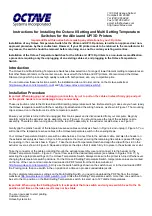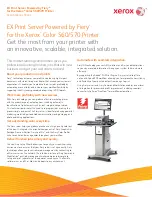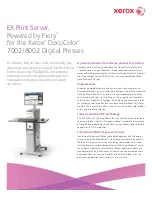
Introduction
The WaxJet™ Model 6100 Wax Jet Printer uses a non-toxic,
non-hazardous solid Wax to produce cost effective small character
codes (up to ½” in height) on to any substrate. The system is
particularly effective on shrink-wrap material.
Nothing touches the product other than the wax itself. There are no
rollers or rubber typefaces to change. Changing the printed message
contents and format is accomplished by simple keyboard entry. The
printer will usually display options available with each command
and show prompts and status information to assist the user.
SystemMaster, a Windows based program, can be used to program
printers (up to 32) from a remote PC.
Small individual drops of wax, fired by the Printhead at precise
times form alphanumeric characters and special graphic characters.
The Printhead ejects wax by microprocessor controlled piezoelectric
crystals that force the wax through tiny orifices, creating very
precise drops of wax. The Printhead firing signals are synchronized
to the movement of the conveyor belt or driven by an internal
oscillator. In either case, a product detect circuit ensures that the
desired message will be printed on the correct location on the
package or carton.
Basic
Operation
Single Phase 110VAC or 220 VAC, 50 or 60 Hz powers Series 6
products. When product detect occurs (usually via photocell sensor),
system will print characters in a dot matrix format. A system clock
or encoder pulses synchronize Printhead firing pulses with product
motion, insuring that printed message is positioned properly on
product. The frequency of the firing pulses combined with the speed
of travel determines the horizontal print resolution of the messages
printed.
Using This
Manual
This manual is designed to provide the FoxJet Authorized Technical
Representative with a service reference that will assist in providing
a high level of support to end-users. This manual is not written for
and should not be distributed to the end user. The manual is not a
substitute for factory training nor is it a replacement for the
Operator’s Manual. It is assumed that the user is familiar with
general mechanical and electrical safety procedures. A section is
provided for the insertion of Technical Bulletins, which are
distributed regularly. Technical Bulletins augment the Service
Reference Manual as equipment or software evolves.
Summary of Contents for 6100
Page 8: ...This page intentionally left blank...
Page 18: ...2 8 Application Design This page intentionally left blank...
Page 21: ...Dimensions Controller Application Design 2 11...
Page 22: ...Integrated Printhead Wax System 2 12 Application Design...
Page 55: ...Command Definitions 5 21...
Page 56: ...5 22 Command Definitions This page intentionally left blank...
Page 70: ...6 14 Installation Setup Figure 6 6...
Page 87: ...7 8 Service Figure 7 1...
Page 89: ...7 10 Service Figure 7 2...
Page 95: ...7 16 Service Figure 7 3...
Page 97: ...7 18 Service This page intentionally left blank...
Page 115: ...8 18 Removal Replacement Procedures Figure 8 7...
Page 125: ...8 28 Removal Replacement Procedures This page intentionally left blank...










































